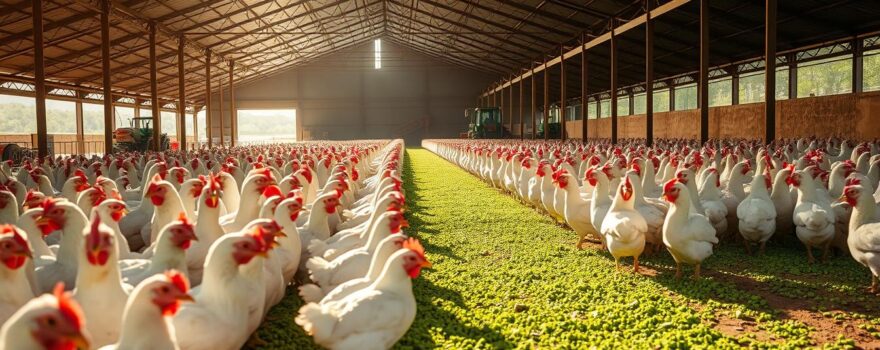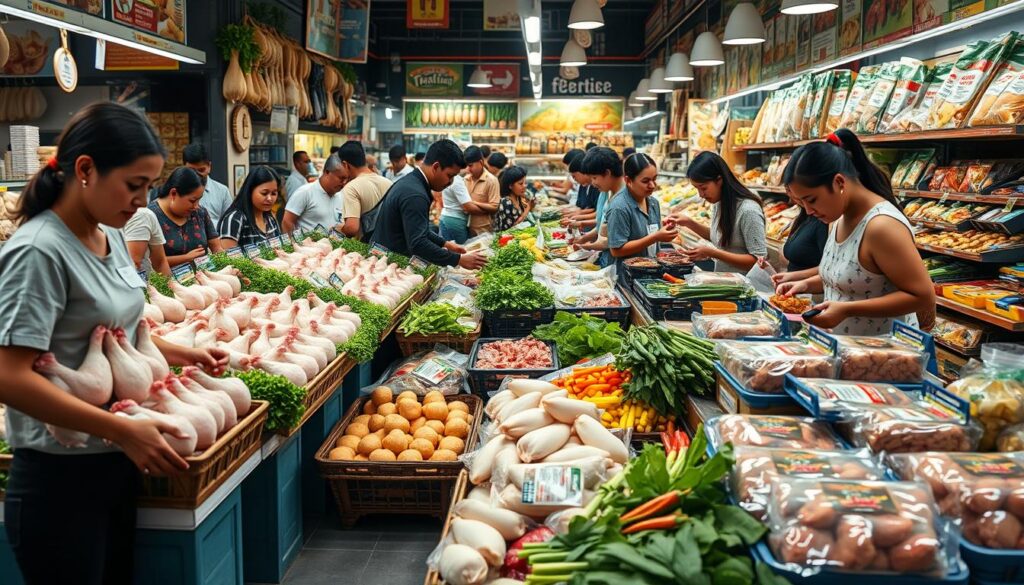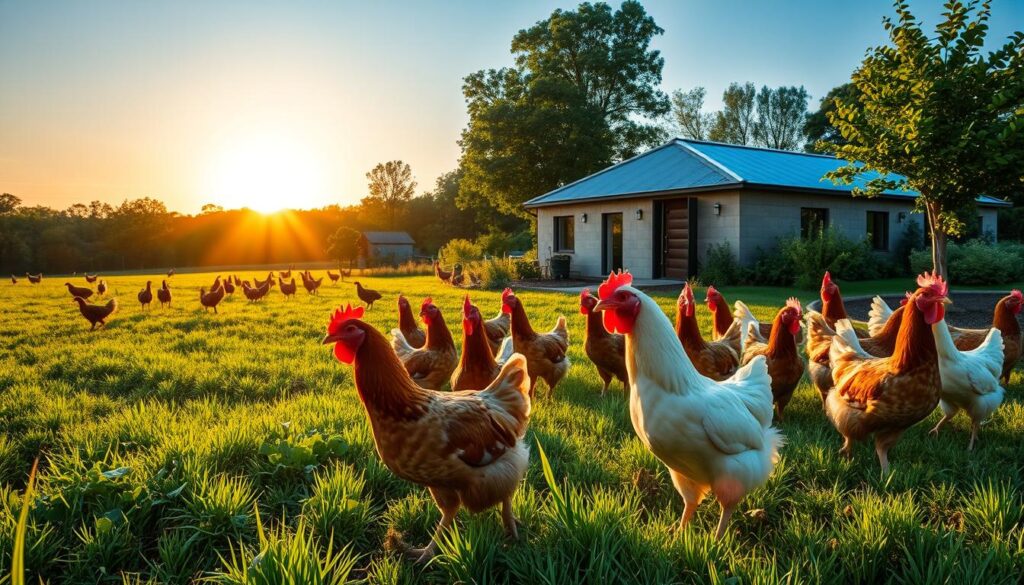
The poultry meat sector has seen steady growth globally in recent years. This growth is thanks to better indoor production and automated processes. In Germany, for example, over 620 million broilers were slaughtered in 2019.
Poultry consumption has gone up by 4.12 kg per person over the last decade. People see chicken as a healthier choice compared to red meat because it has less fat. Chicken’s versatility and taste, along with the industry’s focus on bird health and welfare, have made it a top choice for many.
Key Takeaways
- The poultry industry has experienced steady growth, with 620 million broilers slaughtered in Germany in 2019.
- Poultry consumption has increased in recent years, driven by consumers’ perception of chicken as a healthier meat option.
- Factors such as taste, versatility, and continuous industry improvements in bird health and welfare have contributed to the rise in chicken consumption.
- The Impact of Consumer Preferences on Broiler Chicken Demand is a key factor in the poultry industry’s growth.
- Poultry Industry Trends and Consumer Behavior Analysis are crucial in understanding the dynamics of the broiler chicken market.
Rising Consumer Concern for Animal Welfare
More and more people care about how their food is made and the animals involved. Studies in the EU, North America, Latin America, Asia, and Australia show a big change. Consumer attitudes to farm animal welfare have grown more important over the last 20 years.
In the EU, 94% of people think it’s key to protect farmed animals. Also, six in ten (59%) are ready to spend more for products that show animal care.
Broiler Chicken Welfare Matters to Consumers Worldwide
People all over are worried about broiler chicken welfare and production systems. A big number of adults in 14 countries believe chickens can feel pain and emotions. They also think chickens need space to move and play.
In the UK, 91.7% of adults agree chickens can feel pain. In Thailand, 93.7% agree. Also, 75.1% in the UK and 88.5% in Thailand believe chickens can experience emotions.
This growing interest in sustainable poultry farming practices shows how much broiler chicken welfare matters. As more people want poultry, the industry must listen to these concerns. This way, it can meet new consumer expectations.
Demand for Higher Welfare Production Systems
More people are caring about how chickens are raised. This has led to a big push for better chicken farming. Studies show many people think “free range” and “organic” mean better treatment of animals.
In places like Denmark, France, the Netherlands, and the UK, people are ready to pay more for better chicken. They might pay 5% to 30% extra. In the U.S., some are willing to pay 48% more for chicken that’s been raised well. In Kenya, some urban folks are even willing to pay 72% more for chicken that’s been raised with care.
This shows that people really care about how chickens are treated. They want to support farms that treat animals better. This change can make the chicken industry better and more ethical.
| Country | Consumer Willingness to Pay Premium |
|---|---|
| Denmark, France, Netherlands, UK | 5% to 30%, with some consumers willing to pay 50-100% |
| United States | 48% for chicken breast with welfare certification |
| Kenya (urban consumers) | 72% for chicken with animal welfare labeling |
The need for better chicken farming is clear. It shows how important it is to care for chickens. Farms that treat chickens well can meet the growing demand. This way, they can serve the needs of people who care about animal welfare.
“Consumers are increasingly prioritizing broiler chicken welfare and are willing to support producers who adopt higher welfare production systems.”
The Impact of Consumer Preferences on Broiler Chicken Demand
In recent years, people want more sustainable and better-treated chickens. Price is still key, but caring for animals matters too. Those who care more about animal welfare eat less meat and look for labels.
The broiler industry is changing to meet these new needs. Every year, over nine billion chickens are raised for meat in the U.S. Also, 130 big food companies have joined the “Better Chicken Commitment” to improve animal care. But, changing to better systems is hard, needing more birds, feed, and land.
People are willing to pay more for chicken that’s raised better. They’re willing to pay $0.26 to $0.54 per pound. But, producers need an 8.5% increase to cover the costs of raising these chickens better. This shows the struggle between what consumers want, what it costs, and keeping chicken affordable.
Despite the hurdles, the industry is working hard to meet consumer demands. Antibiotic use in chickens has dropped by nearly half since 2016. Big names like Wayne Farms and Purdue Farms are moving to better standards. Brands that focus on ethics in poultry sales are still doing well.
Changing Consumer Behavior and Buying Habits
Now, people choose chicken raised humanely over taste and sustainability. They want dark meat more, which might mean more investment in better breeds. But, switching to slower-growing breeds would mean more feed, land, and water. It would also cut the U.S. chicken supply a lot.

The broiler industry must balance animal welfare, affordability, and sustainability. It needs to adapt and innovate to meet changing consumer needs. The future of broiler chicken production and consumption depends on it.
Transparent Labeling for Informed Choices
Transparent product labeling is key for consumers to make choices that match their values. It helps shoppers find products that support animal welfare, sustainability, and ethical production. This way, they can buy what they believe in.
Studies reveal that 85% of U.S. consumers worry about confusing labels when buying chicken. They want to know how the chicken was raised. When labels clearly show how animals were treated, more people want to buy products that treat animals better.
Clear Labeling Supports Consumer Demand for Welfare Products
Transparent labeling helps improve farm animal welfare. It lets consumers make choices that are right for them. It also helps producers show off their products that are better for animals.
- 85% of U.S. consumers are concerned about confusing or misleading packaging and label claims when buying chicken.
- Consumers overwhelmingly support method-of-production labeling that indicates how the animal was raised.
- Providing details of animal rearing conditions on the label increases consumer purchasing intention for higher welfare chicken products.
Clear labeling gives consumers the power to choose better. It encourages more sustainable and ethical chicken farming. This way, animals are treated with more care.
Poultry Industry Innovations and Transparency
The poultry industry is moving forward with new ideas to meet consumer needs. New monitoring technologies like audio and video help understand broiler behavior. RFID tags give insights into broiler activity and pasture use, helping farmers make better choices.
Automation is key in solving labor issues in processing. But it works best with uniform flock sizes. These Poultry Industry Innovations and Objective Data Collection methods boost productivity and animal welfare. They also meet the demand for Transparent Production Practices from consumers.
Top poultry producers are opening up their operations to visitors. For example, Perdue Farms has viewing rooms in their broiler houses. This transparency builds trust and answers concerns about animal care.
| Industry Trend | Impact on Poultry Production |
|---|---|
| Precision Agriculture Technologies | Enhanced productivity, cost reduction, and improved animal welfare through real-time data collection and informed decision-making. |
| Automation and Robotics | Reduced labor demands, improved operational efficiency, and consistent management of tasks like feeding, cleaning, and monitoring. |
| Transparency and Traceability | Increased consumer trust and alignment with evolving preferences for ethical and sustainable production practices. |
By using Poultry Industry Innovations, Transparent Production Practices, Objective Data Collection, and Automation and Optimization, the poultry industry can meet demand. It also addresses consumer concerns and offers quality, sustainable products.
Sustainable and Ethical Broiler Chicken Production
Balancing Welfare, Sustainability, and Affordability
The poultry industry faces big challenges. It must focus on Sustainable Poultry Farming Practices, Animal Welfare Metrics, and Environmental Impact. Finding a balance between Broiler Chicken Production Efficiency, animal care, and keeping costs low is key.
Improvements in animal care are ongoing. This includes studying the right mix of light and dark for birds. It also involves using cameras and sound monitoring to check on bird health. Plus, better control over the environment in poultry houses is crucial.
Value is still a big deal for shoppers. With rising costs for everything, from energy to food for animals, prices for poultry are affected. New tech and better internet in rural areas will help farmers manage their farms better. This keeps prices down for consumers.
“Only a few global broiler breeder companies can undertake breeding for better welfare, highlighting the need for industry demand to drive the shift towards slower-growing breeds.”
It’s important to look at the big picture for sustainable farming. This includes how it affects the environment and animal welfare. More research is needed to understand what consumers really want. This will help offset the costs of raising slower-growing chickens.

The broiler chicken industry wants to make more progress in sustainability over the next decade. It plans to use new technology, modern breeding, and better ways to manage nutrients and feed. These steps will help reduce harm to the environment.
Changing Consumer Behavior and Buying Habits
The way people buy meat has changed a lot. Now, many prefer pre-portioned chicken cuts over whole birds. This is because they want things that are easy and quick to use.
This change has affected the poultry industry a lot. It has led to new ways of making chicken and changed how whole chicken vs. cuts are sold.
People want things that are easy to use. They like chicken cuts that don’t take much time to prepare. This has made whole chicken less popular. More people are choosing pre-portioned chicken because it fits their busy lives better.
Some people also don’t want to think about where their meat comes from. This makes them choose specific chicken cuts over whole birds. They feel it helps them not think about the animal it came from.
| Metric | 1970 | 2000 |
|---|---|---|
| U.S. Per Capita Meat Consumption | 194 lbs | 217 lbs |
| Poultry Consumption | 63 lbs | 97 lbs |
| Red Meat Consumption | 153 lbs | 139 lbs |
Changes in how people think about meat and their desire for convenience have led to a drop in whole chicken sales. At the same time, there’s been an increase in demand for specific chicken cuts. The poultry industry has started making changes to meet these new needs. This shows how meat consumption patterns are evolving.
Marketing Whole Chickens from Ideal Farms
As more people want ethically raised poultry, small farms in the U.S. face a challenge. They struggle to sell whole chickens because many customers buy only chicken parts. This trend makes it hard for these farms to market their whole birds well.
But, there’s a chance for these farms to reach more customers. Studies show many U.S. consumers are open to buying whole chickens. They prefer birds raised with care and in alternative methods.
Exploring Consumer Willingness to Change Habits
Recent surveys show U.S. consumers are more aware of their chicken choices. For example, 92% of people buy chicken often, a high in 2016. Many believe conventional chickens are genetically modified or have added hormones and antibiotics.
This awareness has led to a shift in consumer preferences. Big fast-food chains like Chick-fil-A and McDonald’s are now using chicken without important antibiotics. This change is in response to what customers want.
| Consumer Perception | Percentage of Consumers |
|---|---|
| Believe chickens are genetically modified | 78% |
| Believe chickens contain added hormones or steroids | 77% |
| Believe antibiotics are present in most chicken meat | 73% |
This data shows consumers are ready to support farms that care for animals and are transparent. By marketing their whole chickens and the benefits of alternative farming, small farms like Ideal Farms can benefit from this trend.
This detailed study shows how consumer preferences and animal welfare shape the demand for broiler chicken in the U.S. market. People are ready to spend more for chicken from better treatment systems. This shows the value of transparent labeling for making smart choices.
The poultry industry must keep improving to meet consumer needs for sustainability, ethics, and cost. The shift towards buying certain chicken cuts is a challenge. Yet, knowing what consumers want could lead to new chances for marketing whole chickens from farms that are ideal.
The future of the broiler chicken industry depends on balancing what consumers want, animal care, and sustainable practices. By listening to market trends and tackling consumer worries, the industry can grow. It can do this by offering chicken that is ethically sourced and clearly labeled.